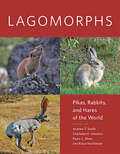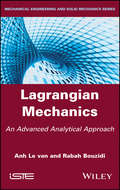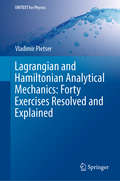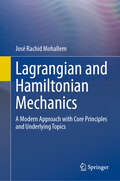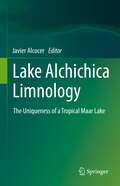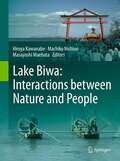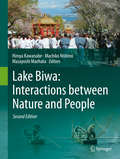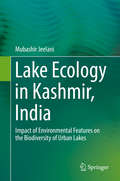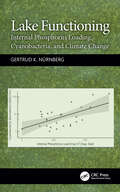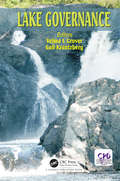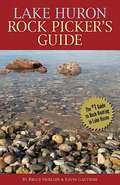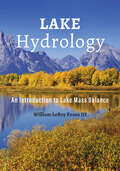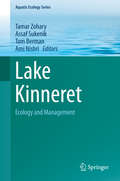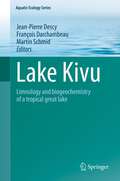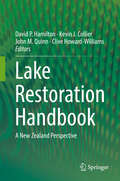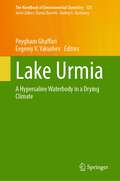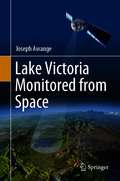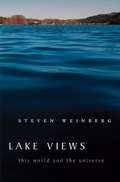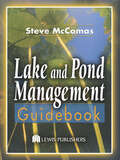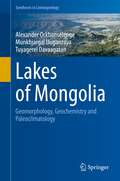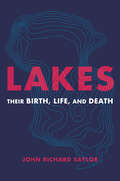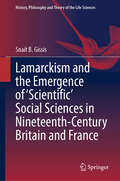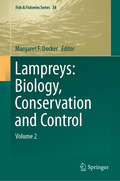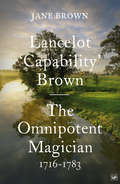- Table View
- List View
Lagomorphs: Pikas, Rabbits, and Hares of the World
by Andrew T. Smith; Charlotte H. Johnston; Paulo C. Alves; Klaus HackländerThe definitive guide to all lagomorphs—pikas, rabbits, and hares.Numbering 92 species worldwide, members of the order Lagomorpha are familiar to people throughout the world, and yet their remarkable diversity and ecological importance are often underappreciated. In this book, Andrew T. Smith and his colleagues bring together the world’s lagomorph experts to produce the most comprehensive reference on the order ever published, featuring detailed species accounts, stunning color photos, and up-to-date range maps. Contributors highlight the key ecological roles that lagomorphs play and explain in depth how scientists around the globe are working to save vulnerable populations.Thematic introductory chapters cover a broad spectrum of information about pikas, rabbits, and hares, from evolution and systematics to diseases and conservation. Each animal account begins with the complete scientific and common names for the species, followed by a detailed description of appearance and unique morphological characteristics, including a range of standard measurements of adult specimens. Subsequent sections discuss known paleontological data concerning the species, the current state of its taxonomy, and geographic variation. Each account also includes dedicated sectioins on habitat and diet, reproduction and development, ecology, behavior, and management. The definitive work on lagomorphs, this book is an invaluable reference for naturalists, professional biologists, and students. It will also be beneficial for those conducting biodiversity surveys and conservation throughout the world.
Lagrangian Interaction: An Introduction To Relativistic Symmetry In Electrodynamics And Gravitation
by Noel DoughtyThis book is an introduction to Lagrangian mechanics, starting with Newtonian physics and proceeding to topics such as relativistic Lagrangian fields and Lagrangians in General Relativity, electrodynamics, Gauge theory, and relativistic gravitation. The mathematical notation used is introduced and explained as the book progresses, so it can be understood by students at the undergraduate level in physics or applied mathmatics, yet it is rigorous enough to serve as an introduction to the mathematics and concepts required for courses in relativistic quantum field theory and general relativity.
Lagrangian Mechanics: An Advanced Analytical Approach
by Anh Le Van Rabah BouzidiLagrangian Mechanics explains the subtleties of analytical mechanics and its applications in rigid body mechanics. The authors demonstrate the primordial role of parameterization, which conditions the equations and thus the information obtained; the essential notions of virtual kinematics, such as the virtual derivative and the dependence of the virtual quantities with respect to a reference frame; and the key concept of perfect joints and their intrinsic character, namely the invariance of the fields of compatible virtual velocities with respect to the parameterization. Throughout the book, any demonstrated results are stated with the respective hypotheses, clearly indicating the applicability conditions for the results to be ready for use. Numerous examples accompany the text, facilitating the understanding of the calculation mechanisms. The book is mainly intended for Bachelor's, Master's or engineering students who are interested in an in-depth study of analytical mechanics and its applications.
Lagrangian and Hamiltonian Analytical Mechanics: Forty Exercises Resolved and Explained (UNITEXT for Physics)
by Vladimir PletserThis textbook introduces readers to the detailed and methodical resolution of classical and more recent problems in analytical mechanics. This valuable learning tool includes worked examples and 40 exercises with step-by-step solutions, carefully chosen for their importance in classical, celestial and quantum mechanics. The collection comprises six chapters, offering essential exercises on: (1) Lagrange Equations; (2) Hamilton Equations; (3) the First Integral and Variational Principle; (4) Canonical Transformations; (5) Hamilton – Jacobi Equations; and (6) Phase Integral and Angular FrequenciesEach chapter begins with a brief theoretical review before presenting the clearly solved exercises. The last two chapters are of particular interest, because of the importance and flexibility of the Hamilton-Jacobi method in solving many mechanical problems in classical mechanics, as well as quantum and celestial mechanics.Above all, the book provides students and teachers alike with detailed, point-by-point and step-by-step solutions of exercises in Lagrangian and Hamiltonian mechanics, which are central to most problems in classical physics, astronomy, celestial mechanics and quantum physics.
Lagrangian and Hamiltonian Mechanics: A Modern Approach with Core Principles and Underlying Topics
by José Rachid MohallemThis book serves as a textbook for an analytical mechanics course, a fundamental subject of physics, that pays special attention to important topics that are not discussed in most standard textbooks. Readers are provided with a clear understanding of topics that are usually inaccessible to the undergraduate level and that are critical to learning Lagrangian and Hamiltonian mechanics. Each chapter also includes worked problems and solutions, as well as additional exercises for readers to try. This book begins with the fundamentals of analytical mechanics, concisely introducing readers to the calculus of variations, Hamilton’s Principle, and Lagrange’s equations. While presenting readers with these core topics, the author uses an intuitive approach to delve into essential questions, such as where Galilean invariance lies in Lagrangian mechanics and how Hamilton’s Principle of Least Action encompasses Newton’s three laws, interesting conclusions that often go unnoticed. Infact, Hamilton’s principle is taken throughout as the very origin of classical physical laws, and the choice of appropriate Lagrangians in each case as the real theoretical challenge, meaning that forms of Lagrangian which differ from the standard one are not mere curiosities but, instead, the general rule. This book clarifies common misunderstandings that students face when learning the subject and formally rationalizes concepts that are often difficult to grasp. In addition, the final chapter provides an introduction to a Lagrangian field theory for those interested in learning more advanced topics. Ideal for upper undergraduate and graduate students, this book seeks to teach the intrinsic meaning of the principles and equations taught in an analytical mechanics course and convey their usefulness as powerful theoretical instruments of modern physics.
Lake Alchichica Limnology: The Uniqueness of a Tropical Maar Lake
by Javier AlcocerThe book provides a comprehensive account of a tropical lake, Alchichica, considering that tropical limnology is by far less known and well-understood than temperate. Many of the well-known temperate limnology paradigms do not apply in tropical limnology, such as the ≥ 1ºC/m thermocline concept, or the role of phosphorous as a limiting nutrient. Lake Alchichica is - most likely – the best limnologically known Mexican lake up to date. Twenty years of continuous monitoring has led us to understand this deep, warm monomictic lake. The peculiar chemical composition of this saline lake – sodium-alkaline with a high concentration in magnesium waters, and groundwater-fed – led to the formation of its unique stromatolite ring that has become world-famous, studied by scientists from various countries. From a biological point of view, this relatively small maar lake displays a comparatively low species richness but surprisingly is plentiful in microendemic species for a recently-formed lake (13,000-6,300 years old, at the Late Pleistocene/Holocene Epoch), eleven of which already described, with more to come. Researchers and students interested in tropical limnology, extreme ecosystems, evolutionary biology, astrobiology, and microbiology will find this book a must-read.
Lake Biwa: Interactions between Nature and People
by Hiroya Kawanabe Machiko Nishino Masayoshi MaehataThis book focuses on the long-term interactions between people and nature in and around Lake Biwa, one of the oldest lakes in the world. Accordingly, it not only covers the characteristics of the biota of this ancient lake, but also approaches it as a 'cultural ancient lake.' Furthermore, various problems affecting the lake, especially recent environmental changes that occurred before and after Japan's rapid economic growth of the 1950s and 60s, are reviewed, including water pollution, lakeshore development and the reclamation of attached lakes, alien and invasive species, and problems related to the recent warming of the climate. Lastly, by analyzing data on these problems collected by the local government and residents of the lake basin, the book provides a comprehensive outlook on the future of Lake Biwa and people's lifestyles. As such, it provides indispensable information for all people engaged in improving and conserving water regimes around the world, as well as people interested in the culture and history of Japan.
Lake Biwa: Second Edition
by Hiroya Kawanabe Machiko Nishino Masayoshi MaehataAlthough, the first edition had a similar focus, more than five years have passed since its publication and the biological and social circumstances of the lake have drastically changed due to, for example, the further expansion of alien species, the decrease of indigenous species, the progress of integrated watershed management by the Union of the Kansai Government which was established in 2010, the legislation of the Conservation and Restoration Act of Lake Biwa in 2015 and more. The new edition will therefore feature updated and new information on the above and more topics as well as updated and revised data based on the latest research. Inventories of respective taxa, especially those of small animals, are also revised based on the latest studies. Furthermore, this volume covers the characteristics of the biota of this ancient lake, but at the same time, it will also approach it as a ‘culture ancient lake’. Other topics also include water pollution, lakeshore development, the effects of global warming in the past and present, the influence of people, and countermeasures by local and national governments. Moreover, the volume also provides a comprehensive view on the future of Lake Biwa and that of its residents. Miraculously enough, this ancient lake has kept its water quality clear even until today despite the fact of more than 1.4 million people living on its shores. Finally, the book also gives indispensable information to those engaged in improving and conserving water regimes of lakes and other water bodies all over the world and to those interested in the culture and history of Japan. Lake Biwa is not only one of the rarest ancient lakes of the world, but the people’s involvement with the lake also goes back a long way. This is shown in the diverse culture developed in this area and in the various archaeological finds that date back as early as the Jomon Period, nearly 10.000 years ago. Today Lake Biwa fulfills an important role as a water resource by providing domestic, commercial, industrial, and agricultural water for over 14 million residents living around the Lake Biwa-Yodo River drainage basin. This updated volume focuses on the geological and biological features of the lake as well as on the long-term interactions between the people and the lake.
Lake Ecology in Kashmir, India
by Mubashir JeelaniThis book highlights the anthropogenic pressures on the fresh water bodies and in particular, the Dal and Anchar Lake. As a result of climate change and global warming there is a likelihood that the glaciers which feed these water bodies may be lost. The lakes discussed in this volume can prove a vital source of information on water and biodiversity as well as the environmental features. The detailed examination of phytoplankton and zooplankton in this volume will prove a key factor for future studies in the field of biology and ecology. An in-depth analysis on the physical-chemical properties of the lakes' water is also presented.
Lake Functioning: Internal Phosphorus Loading, Cyanobacteria, and Climate Change
by Gertrud K. NürnbergThis book explores the interconnections of internal phosphorus loading, cyanobacteria, and climate change and their role in determining water quality in freshwater. It goes on to discuss the sometimes elusive process of internal phosphorus loading with its chemical and biological roots. Reviewing recent observations on present and future climate change, the book explores its effects on lake functioning. It concludes with the abatement and prevention of cyanobacteria proliferation, including techniques that deal with internal phosphorus loading. Some key topics covered are: In-depth exploration of internal phosphorus loading and its quantification in global lakes with diverse morphometry, hydrology, geochemistry, and degree of eutrophication. Determination of climate change effects on physical, chemical, and cyanobacteria-related variables in tables based on more than 100 reviewed journal articles. Evidence for the enhancing influences of climate change on internal phosphorus load and cyanobacteria, and of internal load on cyanobacteria. This book will be of interest to limnologists, environmental and engineering professionals, and natural science students. It will also be an interesting read to government agents, lake managers, and others interested in maintaining lake water quality and understanding algal blooms.
Lake Governance: Lessons In Participatory Governance
by Velma I. Grover Gail KrantzbergThe Lake Governance book will focus on comparative analysis of governance structures by examining policy, legal and institutional structures of current transboundary commissions to develop a common framework for good governance of transboundary lakes. Cooperation among nations sharing natural resources is important for sustainable use of the shared resources. Lakes contribute a big part to GDP in most of the countries and in some cases are also responsible for providing fisheries (for food, source of protein and livelihood). Climate change and associated risks and uncertainties add more complexity to the problems. This book will explore current water governance challenges, knowledge gaps and recommend a framework for good lake governance.
Lake Huron Rock Picker's Guide
by Bruce Mueller Kevin GauthierBruce Mueller is owner of the C&M Rock Shop in Honor, Michigan. He holds a master's degree in geology from the University of Illinois. He is also the author of The Complete Guide to Petoskey Stones. Kevin Gauthier is a business graduate from Michigan State University and has completed courses through Gem Institute of America (GIA). He has spent a lifetime collecting, cutting, and polishing the gems found around Lake Huron. Kevin is co-author with Bruce Mueller of Lake Michigan Rock Picker's Guide and Lake Superior Rock Picker's Guide. He is owner of Korner Gem in Traverse City, Michigan: www. kornergem.com.
Lake Hydrology: An Introduction to Lake Mass Balance
by William LeRoy Evans IIIThe first book dedicated to describing the hydrology of water flow in lake systems, geared for limnologists and students of hydrology.With fresh water becoming a critical issue around the world, lake mass balance—the hydrology or water movement in lakes—is increasingly important to environmental studies and remediation projects. Unfortunately, lake hydrology is often only briefly covered in broader texts on hydrogeology and hydrology or is confined to specialized research papers. Lake Hydrology rigorously describes the hydrology of flow into and out of lake systems. Explaining the physical parameters that influence lake behavior, as well as the mathematics that describes these systems, this in-depth book fills an important niche in the literature of watershed science. This text• describes the physical structure and nature of drainage basins and explains the origin and classification of lakes• explores the hydrology of lake mass balance and storage as it pertains to lake stage, groundwater and lake bottom interaction, hypsometry, lake hydraulics, precipitation, surface flow, evaporation, and transpiration• provides models, practical information, and solutions for lake management or remediation planning utilizing basic data, including stage fluctuation, evapotranspiration, lake-bottom seepage, precipitation, and surface flow • uses examples from real-world long-term studies, including Utah's Great Salt Lake and Florida's Lake Jackson, a karstic lake system• examines the effect of storm events including the temporal and areal distribution of rainfall, and flow paths of water in the catchment from precipitation• includes an introduction to relevant scientific principles, such as dimensional analysis, the properties of water, and the hydrologic cycleUnlike most limnology texts, which emphasize lake ecology and biology, Lake Hydrology is designed to truly elucidate the hydrology of lake systems, especially as it relates to components of the hydrologic cycle. This book will greatly benefit professionals and researchers involved in lake management, remediation, or investigation of lake systems, and can be used as is or integrated within graduate and advanced undergraduate courses in limnology.
Lake Kinneret
by Tamar Zohary Assaf Sukenik Tom Berman Ami NishriThis condensed volume summarizes updated knowledge on the warm-monomictic subtropical Lake Kinneret, including its geophysical setting, the dynamics of physical, chemical and biological processes and the major natural and anthropogenic factors that affect this unique aquatic ecosystem. This work expands on a previous monograph on Lake Kinneret published in 1978 and capitalizes on the outcome of more than 40 years of research and monitoring activities. These were intensively integrated with lake management aimed at sustainable use for supply of drinking water, tourism, recreation and fishery. The book chapters are aimed at the limnological community, aquatic ecologists, managers of aquatic ecosystems and other professionals. It presents the geographic and geological setting, the meteorology and hydrology of the region, continues with various aspects of the pelagic and the littoral systems. Finally, the last section of the book addresses lake management, demonstrating how the accumulated knowledge was applied in order to manage this important source of freshwater. The section on the pelagic system comprises the heart of the book, addressing the major physical processes, external and internal loading, the pelagic communities (from bacteria to fish), physiological processes and the major biogeochemical cycles in the lake.
Lake Kivu
by Jean-Pierre Descy Martin Schmid François DarchambeauIn the heart of Africa, a unique lake attracts the attention of scientists since the beginning of the 20th century. At the foot of the Virunga volcano chain, Lake Kivu harbors a vast amount of dissolved carbon dioxide and methane, making this lake the most dangerous lake on Earth. But the lake furnishes also many goods and services for surrounding populations and may soon become the most important energy supplier in the area. At the beginning of gas exploitation, the time has come for gathering the large amount of scientific information acquired during past and present research on Lake Kivu. The eleven chapters cover many aspects of the physics, geochemistry and biology of the lake, with a particular focus on the unique physical and geochemical features of the water column and on the ecological functioning of the surface waters. The impacts of the introduced fish species and the potential impacts of methane exploitation are also summarized. This multi-disciplinary book may also be used as an introduction to the limnology and biogeochemistry of large tropical lakes, as it covers various aspects of the physics, geochemistry, biology and ecology of the African Great Rift lakes.
Lake Restoration Handbook: A New Zealand Perspective
by David P. Hamilton Kevin J. Collier John M. Quinn Clive Howard-WilliamsLakes across the globe require help. The Lake Restoration Handbook: A New Zealand Perspective addresses this need through a series of chapters that draw on recent advances in modelling and monitoring tools, citizen science and First Peoples’ roles, catchment and lake-focused restoration techniques, and policy implementation. New Zealand lakes, like lakes across the globe, are subject to multiple pressures that have increased in severity and scale as land use has intensified, invasive species have spread and global climate change becomes manifest. This books builds on the popular Lake Managers Handbook (1987), which provided guidance on undertaking investigations into, and understanding lake ecosystems in New Zealand. The Lake Restoration Handbook: A New Zealand Perspective synthesises contemporary issues related to lake restoration and rehabilitation, integrated with social science and cultural viewpoints, and complemented by authoritative topic-area summaries by renowned scientists and practitioners from across the globe. The book examines the progress of lake restoration and the new and emerging tools available to managers for predicting and effecting change. The book will be a valuable resource for natural and social scientists, policy writers, lake managers, and anyone interested in the health of lake ecosystems.
Lake Urmia: A Hypersaline Waterbody in a Drying Climate (The Handbook of Environmental Chemistry #123)
by Evgeniy V. Yakushev Peygham GhaffariThis book provides a holistic review of the environmental status of Lake Urmia in terms of its hydrodynamic, chemical, and ecological properties. Lake Urmia is a shallow landlocked hypersaline water body located in the northwest part of Iran, and it is known as one of the largest continental salt lakes in the world. Divided into 16 chapters, the book gathers leading experts from various scientific disciplines, and it covers past and current characteristics of the lake and traces projections on how the water quantity, quality, chemical, and ecological state of Lake Urmia Basin can develop in the future. The book outcomes are based on the analyses of the data of observations and unique models that were elaborated for the Lake Urmia system development studies. Particular attention is given to the basin drought in response to anthropogenic drivers and environmental pressures such as climate variability and climate change and their impact on the aquatic environment. The impact of water conveyance on Lake Urmia to improve the physical, chemical, and biological natural state is also discussed in this book, where an intensive and challenging observation plan in this harsh environment is combined with uniquely coupled and adopted hydrodynamical-biogeochemical models. Given its scope, the book offers an invaluable source of information for researchers, students, and environmental managers interested in the Lake Urmia environment.
Lake Victoria Monitored from Space
by Joseph AwangeThis book employs a suite of remotely sensed products and advanced technologies to provide the first comprehensive space-based sensing of Lake Victoria, the world’s second largest freshwater lake that supports a livelihood of more than 42 million people, modulates regional climate, but faces myriads of challenges. Proper understanding of the lake and changes in its physical dynamics (e.g., water level, shorelines and areal dynamics) resulting from the impacts of climate variation and climate change as well as anthropogenic (e.g., hydropower and irrigation) is important for its management as well as for strategic development before, during and after climate extremes (e.g., floods and droughts) in order to inform policy formulations, planning and mitigation measures. Owing to its sheer size, and lack of research resources commitment by regional governments that hamper its observations, however, it is a daunting task to undertake studies on Lake Victoria relying solely on in-situ “boots on the ground” measurements, which are sparse, missing in most cases, inconsistent or restricted by governmental red tapes. To unlock the potentials of Lake Victoria, this book argues for the removal of obsolete Nile treaties signed between Britain, Egypt and Sudan in the 1920s and 1950s, which prohibits its utilization by the upstream countries. The book is useful to those in water resources management and policy formulations, hydrologists, environmentalists, engineers and researchers.In a unique cross-disciplinary approach, the Book articulates the various climatic impacts and explanations from natural and anthropogenic origins, which affected Lake Victoria and its vicinity, including the drastic increase and depletion of water level in the Lake and dams, floods and droughts, water quality/security, crop health, food security, and economic implications. With no exception as in his many publications, Joseph L. Awange used data analysis methodologies including filtering, adjustment theory, and robust statistics, to quantify the hydrologic and other parameters, and their estimated uncertainties. The Book is recommended for readers from a diverse disciplines, including physical and social sciences, policy, law, engineering, and disaster management. Professor C.K. Shum, Ohio State University.
Lake Views: This World and the Universe
by Steven WeinbergA Physics World Top Ten Book of 2010Steven Weinberg, considered by many to be the preeminent theoretical physicist alive today, continues the wide-ranging reflections that have also earned him a reputation as, in the words of New York Times reporter James Glanz, a powerful writer of prose that can illuminate-and sting.
Lake and Pond Management Guidebook
by Steve McComasThe Lake and Pond Management Guidebook is the successor to the bestselling Lake Smarts: The First Lake Maintenance Handbook, the "bible" for small-scale lake and pond improvements, published by the Terrene Institute in 1993. Completely revised and updated, now published by Lewis Publishers, this guidebook contains over 300 ideas and projects includ
Lakes of Mongolia: Geomorphology, Geochemistry and Paleoclimatology (Syntheses in Limnogeology)
by Alexander Orkhonselenge Munkhjargal Uuganzaya Tuyagerel DavaagatanThis book provides an overview of lakes in Mongolia from scientific, economic and scenic points of view, presenting lake area changes, their sedimentological and geochemical characteristics, valuable economic and geoheritage resources and paleoclimate change reconstruction. The book emphasizes internationally well-known lakes of Mongolia, but it also describes far less popular lakes which have remained unrecognized for scientific importance. The book offers modern, qualitative, process-oriented approaches and quantitative analytic results-based implications to understand the geomorphological, sedimentological and geochemical evolution of lake basins in Mongolia, and past and present climate changes in Mongolia and Eurasia. Insights into the interpretation of data obtained from the lake basins in the fields of geomorphology, sedimentology, geochemistry, geochronology and paleoclimatology are developed from theoretical principles, empirical observations, correlative illustrations, analytic measurements and conscious hypotheses. Based on the application of a combined compilation of recent Landsat 8 images of the lakes and topographic maps of them in 1970, this book presents enriched results and implications derived from remote sensing together with field measurements and laboratory analyses. This data compilation belongs to a research team at the Laboratory of Geochemistry and Geomorphology (LGG), National University of Mongolia (NUM).
Lakes: Their Birth, Life, and Death
by John Richard Saylor&“Lakes is my favorite kind of natural history: meticulously researched, timely, comprehensive, and written with imagination and verve.&”—Jerry Dennis, author of The Living Great Lakes Lakes might be the most misunderstood bodies of water on earth. And while they may seem commonplace, without lakes our world would never be the same. In this revealing look at these lifegiving treasures, John Richard Saylor shows us just how deep our connection to still waters run. Lakes is an illuminating tour through the most fascinating lakes around the world. Whether it&’s Lake Vostok, located more than two miles beneath the surface of Antarctica, whose water was last exposed to the atmosphere perhaps a million years ago; Lake Baikal in southern Siberia, the world&’s deepest and oldest lake formed by a rift in the earth&’s crust; or Lake Nyos, the so-called Killer Lake that exploded in 1986, resulting in hundreds of deaths, Saylor reveals to us the wonder that exists in lakes found throughout the world. Along the way we learn all the many forms that lakes take—how they come to be and how they feed and support ecosystems—and what happens when lakes vanish.
Lamarckism and the Emergence of 'Scientific' Social Sciences in Nineteenth-Century Britain and France (History, Philosophy and Theory of the Life Sciences #36)
by Snait B. GissisThe book presents an original synthesizing framework on the relations between ‘the biological’ and ‘the social’. Within these relations, the late nineteenth-century emergence of social sciences aspiring to be constituted as autonomous, as 'scientific' disciplines, is described, analyzed and explained. Through this framework, the author points to conceptual and constructive commonalities conjoining significant founding figures – Lamarck, Spencer, Hughlings Jackson, Ribot, Durkheim, Freud – who were not grouped nor analyzed in this manner before. Thus, the book offers a rather unique synthesis of the interactions of the social, the mental, and the evolutionary biological – Spencerian Lamarckism and/or Neo-Lamarckism – crystallizing into novel fields. It adds substantially to the understanding of the complexities of evolutionary debates during the last quarter of the nineteenth century. It will attract the attention of a wide spectrum of specialists, academics, and postgraduates in European history of the nineteenth century, history and philosophy of science, and history of biology and of the social sciences, including psychology.
Lampreys: Volume 2 (Fish & Fisheries Series #38)
by Margaret F. DockerThis book, published in two volumes, provides the most comprehensive review of lamprey biology since Hardisty and Potter’s “The Biology of Lampreys” published more than 30 years ago. This second volume offers a synthesis of topics related to the lamprey gonad (e.g., lamprey sex ratios, sex determination and sex differentiation, sexual maturation, and sex steroids), the artifical propagation of lampreys, post-metamorphic feeding and the evolution of alternative feeding and migratory types, the history and status of sea lamprey control in the Laurentian Great Lakes and Lake Champlain, and an overview of contributions of lamprey developmental studies for understanding vertebrate evolution.
Lancelot 'Capability' Brown, 1716-1783: The Omnipotent Magician
by Jane BrownLancelot Brown changed the face of eighteenth-century England, designing country estates and mansions, moving hills and making flowing lakes and serpentine rivers, a magical world of green. This English landscape style spread across Europe and the world. At home, it proved so pleasing that Brown's influence spread into the lowland landscape at large, and into landscape painting. He stands behind our vision, and fantasy, of rural England. In this vivid, lively biography, based on detailed research, Jane Brown paints an unforgettable picture of the man, his work, his happy domestic life, and his crowded world. She follows the life of the jovial yet elusive Mr Brown, from his childhood and apprenticeship in rural Northumberland, through his formative years at Stowe, the most famous garden of the day. His innovative ideas, and his affable and generous nature, led to a meteoric rise to a Royal Appointment in 1764 and his clients and friends ranged from statesmen like the elder Pitt to artists and actors like David Garrick. Riding constantly across England, Brown never ceased working until he collapsed and died in February 1783 after visiting one of his oldest clients. He was a practical man but also a visionary, always willing to try something new. As this beautifully illustrated biography shows, Brown filled England with enchantment - follies, cascades, lakes, bridges, ornaments, monuments, meadows and woods - creating views that still delight us today.
